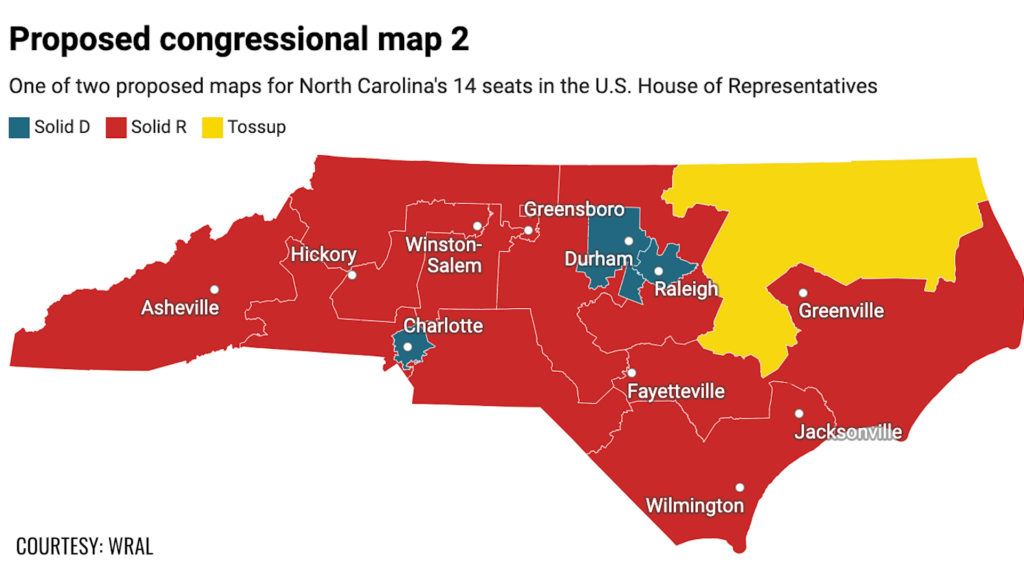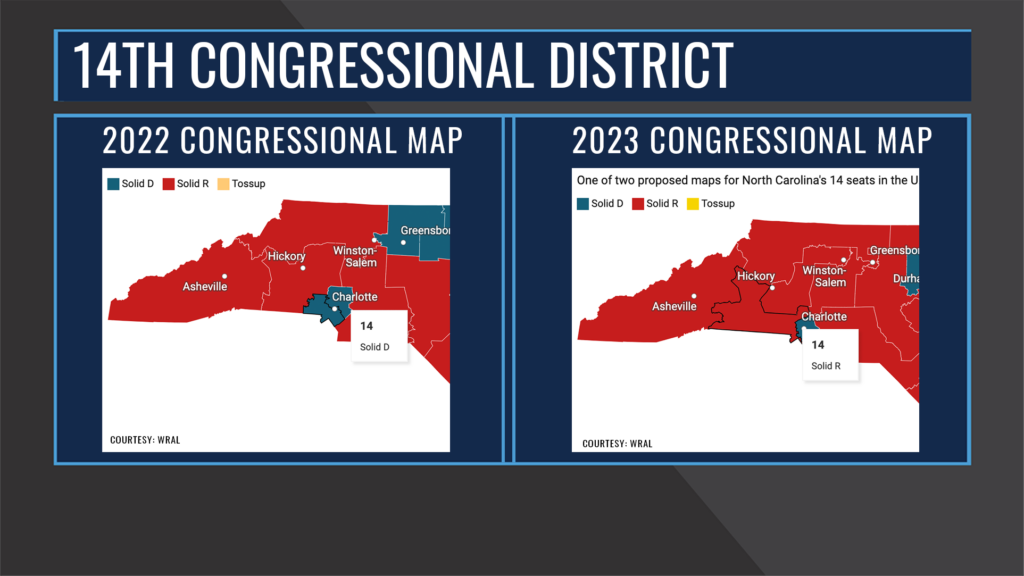RALEIGH, N.C. — For the third time in as many years, the North Carolina General Assembly redrew the lines for legislative and congressional districts. The General Assembly enacted three new maps on Wednesday: one for Congress, one for the state house, and one for the state senate.
All three maps will strengthen Republicans’ hold on power in North Carolina.
North Carolina’s current congressional map was drawn by a state court-ordered commission in 2022, and currently has a 7-7 split.
Republicans originally proposed two different Congressional maps for next year, both of which increase their seats in the US House. The map the General Assembly ended up enacting likely gives Republicans 10 House seats, with the potential to win 11.

Dave Wasserman, a senior elections analyst at the Cook Political Report, says this 3 to 4 net gain for Republicans could determine the majority in the US House next year.
“The House could be decided by that close a margin in 2024,” Wasserman says. “So there is a chance that control of the House will come down to what transpires in North Carolina’s redistricting process.”
The map draws Democrats Kathy Manning, Wiley Nickel, and Jeff Jackson out of their districts by redrawing them so that they contain less urban, Democrat areas and more rural, Republican areas.
For example, Representative Jeff Jackson currently represents the 14th District, which under the old maps, contained mostly Charlotte suburbs, a reliably Democratic area. Under the new map, his district now contains less of those suburbs, and more of the western, rural part of the state, turning the district reliably Republican. Other Congressional Democrats were drawn out of their districts in similar ways.

Of note is that the new 14th District contains NC House Speaker Tim Moore’s Cleveland County home. Moore said Tuesday that he is considering a run for Congress.
Representative Don Davis, currently representing the 1st District, is now in a much harder district that no longer contains Greenville, and thus could also lose his seat.
Republicans also enacted new state House and Senate maps that are more advantageous to them.
According to an analysis from researchers at Duke University using previous election data, Democrats would typically break Republicans’ supermajority in the House and Senate in 2024 under the old maps.
But, the new maps preserve the supermajority in most cases. While Democrats have a better chance of breaking the supermajority in the House, the analysis shows that Republicans will keep their supermajority in both chambers even as the Democratic vote share approaches 50 percent.
The maps make it nearly impossible for Democrats to gain a majority, even if they win the statewide vote by a significant margin. Republicans would keep their majority in both chambers even if Democrats win 52 percent of the statewide vote, according to the analysis.
Democrats in the state have taken issue with this round of redistricting, saying that the process of drawing the maps was too secretive.
In a statement last Wednesday, Democratic Governor Roy Cooper said “Drawn in the back room and armed with their new law that keeps their plotting secret, they have used race and political party to create districts that are historically discriminatory and unfair”.
The law Governor Cooper is referring to was a provision in the state budget that removed all communications regarding redistricting from the public record. Successful legal challenges in previous years used some of these communications as evidence, but any legal challenge now will not be able to.
NC Democrats have also said that the maps unfairly benefit Republicans.
Republicans are allowed to create clearly partisan maps. That’s because of a decision by the Republican-majority state Supreme Court last year that legalized partisan gerrymandering in the state.
But the new maps will still certainly face challenges in the courts. The maps cannot be based on racial considerations, and this will likely be the crux of the inevitable lawsuits against the new election maps.
The new congressional 1st district dilutes the Black voting share in the district, setting up for a lawsuit based on the Voting Rights Act.
The new state Senate map also redraws the 8th district so that it carves out Black neighborhoods in Wilmington and puts them in a district with rural counties. Republicans say that this was done for purely political purposes.
Although, Mitch Kokai, a senior political analyst at the John Locke Foundation, says the lack of a standard for racial gerrymandering makes it hard to predict what the Supreme Court will do in this case.
“They basically say in almost all of their rulings, well, you got it wrong and you got to go back and do it again,” Kokai says “And they don’t give them a bright line standard of what works and what doesn’t. So it really depends on where the courts want to go next with this.”
While a lawsuit in the U.S. Supreme Court is almost guaranteed, with the 2024 election being just over a year away, there’s a good chance you’ll be voting within these maps in the 2024 election.
“But I suspect that this will drag on well past the 2024 elections, which means that Republicans are likely to get the map that they want for at least this next cycle,” Wasserman says.
Without any successful challenges, these election maps will be in place until after the next census in 2030.
